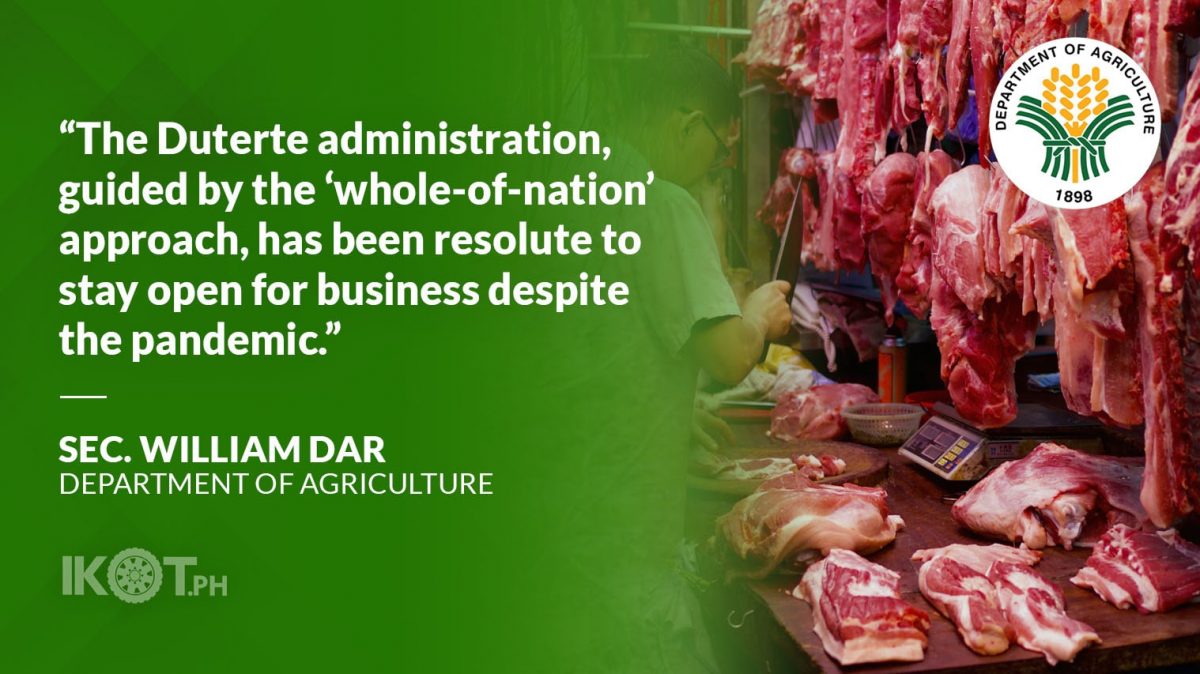The Department of Agriculture (DA) presented several “whole-of-nation” measures to increase hog production and revive the industry, and reduce prices of pork in retail markets.
These include the provision of transport support to help raisers and traders bring their hogs and pork products from Visayas and Mindanao to key markets in Metro Manila (MM).
Agriculture Secretary William Dar presented the measures during a hearing of the Senate committee on agriculture and food (SCAF), following the approval of Executive Order (EO) No. 124 by President Rodrigo Duterte imposing a price ceiling on pork and chicken products in the National Capital Region (NCR).
“We are ready to provide shipping and or transportation support and help bring down prices of pork, and make the implementation of the price ceiling in Metro Manila attainable,” Dar said during the SCAF hearing chaired by Senator Cynthia Villar.
Under EO 124, a price ceiling of ₱270/kg for kasim/pigue, ₱300/kg for liempo, and ₱160/kg for dressed chicken will be implemented for 60 days in Metro Manila.
In approving the EO, the President noted that the reduced local pork output due to the outbreak of the African swine fever (ASF) has significantly affected the supply and prices of pork in the market.
EO 124 also stated that the current retail prices of basic necessities in NCR such as pork and chicken have increased significantly, causing undue burden to Filipinos, especially the underprivileged and marginalized.
The DA blames the high prices to traders and wholesalers who unreasonably jacked up the prices of kasim/pigue and liempo, ranging from P360 to P400/kg, in December onto January 2021 while farmgate prices of hogs remained at P130 to P210/kg.
The agriculture chief has directed all DA regional directors in Visayas and Mindanao, including those in ASF-free areas in Luzon, to coordinate with concerned hog raisers and traders to implement the transport support.
Further, the agriculture head said the DA is now coordinating with the logistics sector and other concerned agencies, particularly the Department of Interior and Local Government (DILG) on the implementation of the “special hog lanes” or food highways to ensure the continuous and unhampered flow of pork and other agri-fishery products to and from Luzon-Visayas-Mindanao.
Earlier, the Inter-Agency Task Force for the Management of Emerging Infectious Diseases (IATF-EID) approved the recommendation of the IATF task group on food security to declare the Maharlika Highway and “nautical highway,” connecting Luzon to Mindanao, as special hog lanes.
“The Duterte administration, guided by the ‘whole-of-nation’ approach, has been resolute to stay open for business despite the pandemic. We are heartened by the swift action by the members of the AITF in opening up the special hog lanes that will ensure the availability of nutritious and affordable food for the Filipino people,” he said.
“The unhampered movement of pork and other food items should result in lower prices at retail markets.”
“The unhampered movement of pork and other food items should result in lower prices at retail markets as traders and viajeros will no longer have any excuse about logistics and transport of agri-fishery products,” Dar added.
He also expects that the recent IATF policy will spur economic growth along the food highways – including logistics (such as Ro-Ro ships, reefer ships, trucks and vans), financial institutions, and services sectors.
“When the agriculture sector grows, other sectors of the economy follow.”
“When the agriculture sector grows, other sectors of the economy follow,” Dar added.
The other “whole-of-nation” measures being pursued by the DA in partnership with the local government units, veterinary groups, academe, hog raisers and traders are:
1. Increase hog production through a repopulation program in ASF-free areas with an initial budget of P600 million (M); implementation of massive Bantay ASF sa Barangay; distribution of ASF rapid test kit; stricter quarantine checkpoints; increased anti-smuggling efforts; strict adherence to food safety; stronger collective action with LGUs; provision of financing for backyard and commercial hog raisers, with an initial P15.5-billion loan facility from Land Bank of the Philippines and DA-Agricultural Credit and Policy Council;
2. Mobilize supply from surplus provinces to NCR; open “special hog lanes”; sell pork through DA-Kadiwa outlets; impose price ceiling; mobilize local price coordinating councils (LPCCs), Bantay Presyo Task Force, and economic intelligence team;
3. Encourage consumers to diversify and patronize other protein sources like chicken, fish, egg, and legumes; and
4. Allow pork imports.

